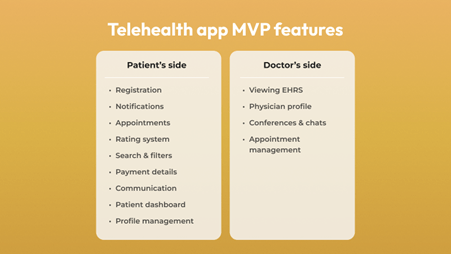The market for healthcare technology is growing rapidly. It is projected to be worth over $440 billion this year.
The leverage of software products for healthcare processes, known as telehealth, has gained popularity in recent years. Since the number of individuals employing telehealth persists to rise, demand for telehealth app software to support patient treatment and improve vendor-consumer interactions has increased.
While reading this guide, you will uncover the expenses involved in assembling a telehealth solution, the necessary, relevant set of features for successful telehealth apps, and potential challenges that could arise at each implementation phase. This will give you more perspectives on why technology is changing the future of healthcare.
How Do Telemedicine Apps Work?
Telemedicine refers to a technique of supplying distant customer care operating e-solutions. It has helped refine the availability of medical assistance for individuals in regions without sufficient medical facilities and those with restricted mobility. Telemedicine also provides a more efficient way for healthcare providers to offer quality medical care.
Telehealth includes telemedicine, education, tele pharmaceuticals, and document management. It covers both clinical diagnoses and preventive care measures. Telehealth platforms use reliable online power to stream data, making it straightforward for medical vendors and physicians to enter clients’ progress from anywhere. Clinicians can also execute interactive discussions not considering their distance or geography.
Why Build a Telemedicine App?
Telemedicine-based digital products deliver a diversity of values to consumers and enterprises. It provides patients with the opportunity to order and get medical care quickly and conveniently not leaving their residence. They also decrease time and expenses by excluding the need to travel to a physician’s office or hospital. Medical advice, prescriptions, and details are available in minutes via telemedicine software. Managing their healthcare is more effortless for all sides using the app.
Telemedicine app development offer firms the perks related to outlay savings as well as improved customer loyalty. Employment and adoption of telemedicine products can assist enterprises to lower their overhead costs and offer savings to their customers by avoiding the expenses of an office-based practice. Telemedicine apps provide a convenient experience that may result in increased customer loyalty for businesses.
Technical Side of Telemedicine App Development
To construct a telemedicine product, compile a functionality range to choose instruments for the future product. The app requires a customer’s and doctor’s side with different tools for each party.
Telemedicine App Features for Patients
Within the flow of implementing a telemedicine solution, it is core to take into account the audience’s expectations of the catering. Patient-side telemedicine apps typically include common features.
- Online appointments and booking
- Telehealth visits with video meetings
- Protected doctor-patient messaging
- Prescription renewal requests
- Personalized health data tracking
- Electronic charges
Telemedicine App Features for Physicians
The feature of secure messaging is crucial for healthcare providers, which enables to communicate confidentially with customers and additional healthcare professionals, especially when dealing with sensitive health information.
Physician-side telemedicine products commonly incorporate diverse features:
- Online patient profiles
- Electronic prescriptions
- Digital client documents
- Admission to lab test outcomes and images
- Video meetings for distant appointments
- Calendar and scheduling tools

How Much Does It Cost to Develop a Telemedicine App?
The expenses required for implementing a telemedicine product may be affected by a number of characteristics. Firstly, the sort of product you want will impact the expenditures; fundamental info and interaction app creation tend to come as the least expensive option but for more complex options to illustrate, electronic prescriptions, analytics, or scheduling systems prognosis a heftier cost. Secondly, the group that designs your platform should consist of people with technical specialization and background in this field; the better they are –the better quality of outcome and services you will end up with – thus being reflected in pricing too. Last but not least, also consider where the team is located as there can be some price discrepancies worldwide and from what we know many pricing options can range between $75,000 and $250,000.
When developing a telemedicine app, it is important to consider cost-effectiveness and work with experienced developers who can meet your requirements. It is also advisable to prepare for any potential delays in the development process.
Monetization Strategies for Telehealth Apps
Healthcare app development and monetization can be done in a variety of ways. The most common method is through subscription or pay-per-use fees. This includes charging for video consultations, messaging services, and other app features. Additionally, physicians may charge for follow-up visits and additional services that are provided outside of the app.
Advertising is another way to monetize a telemedicine app as it allows businesses to generate revenue without impacting user experience. Ads can be used to promote products or services related to healthcare such as health insurance plans or medical equipment. App owners can also partner with pharmaceutical companies who might offer promotional deals on medications and supplements in exchange for ad placement.
In-app purchases are also a popular option among businesses looking to monetize their telemedicine apps. In-app purchases include virtual goods such as additional storage space or premium features that users must pay for in order to access certain content or capabilities within an app.
Conclusion
Developing a telehealth app requires considering costs and other factors. Success takes time and a proper approach. Starting with goals and objectives is important. Finding partners for development, hosting, and maintenance is essential. Revenue generation should be planned out. It’s also crucial to analyze costs and benefits for financial understanding.
With careful planning, telemedicine apps can revolutionize patient care and make it more accessible and convenient.